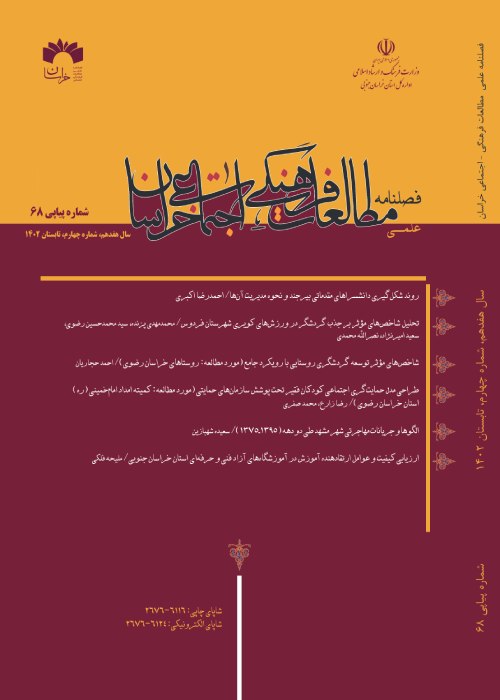Identifying and Analyzing Effective Cultural Drivers of Development in the South Khorasan Province: The Components of Public Culture in Focus
Clark (2006) argues that wherever there is a successful development experience, there is also a specific culture that has a unique way of viewing humans, the world, human activity, noble work, and human mission on Earth. Southern Khorasan province is considered one of the least developed provinces in Iran, and there is a variety of opinions and views about the causes of this underdevelopment. While underdevelopment can be attributed to a variety of political, economic, and geographic factors, this research aims to investigate the role of culture in shaping underdevelopment by evaluating and measuring the role of dominant public cultural components in Southern Khorasan province. In essence, this research seeks to identify the key public cultural drivers that either hinder or support the province’s development process. To achieve this goal, the following three key questions will be addressed to some extent based on the information collected during the survey:What are the most important public cultural characteristics of Southern Khorasan that favor and promote development? What are the most important public cultural characteristics of Southern Khorasan that hinder development? To what extent have the province’s cultural capacities been used to promote development in Southern Khorasan?
This applied, descriptive-analytical research used a mixed-methods approach, including literature review, library research, and survey. The target population was experts on culture and development. The Cochran formula was used to estimate the sample size, which was determined to be 30. A simple random sampling method was used to select the sample. A researcher-made questionnaire was used to collect data. The questionnaire was first validated by a group of experts (n = 8). Cronbach's alpha coefficient was then used to assess the reliability of the questionnaire, which yielded values of 0.78 and 0.89 for the characteristics of general culture in favor of development and as an obstacle to development, respectively. Once the questionnaires were distributed and collected, appropriate descriptive and inferential statistics (group t-test and Friedman test) were used to analyze the data and test the hypotheses. All statistical analyses were performed using SPSS version 23 software.
The first and second questions were exploratory in nature and aimed to identify the cultural features and characteristics that support or hinder the development of the public culture. The data were collected from the elites and the survey respondents. The results showed that the top 10 traits and features of a public culture that fosters development were, in order of priority: 1. History of education and training regarding public culture, 2. The spirit of tolerance and acceptance (interaction between Shi’ite and Sunni), 3. Respect for the social order and the rights of others, 4. High sense of responsibility among the people, 5. Collective spirit for the development of the province, 6. Mutual respect and hospitality, 7. Self-governance of the people of the province, 8. The role of professional commitment or conscientiousness, 9. Observance of citizenship rights in the province, and 10. Adherence to customs and traditions.The results of the second question showed that the 10 most important features and characteristics of a public culture that impedes development were, in order of priority: 1. People’s local biases, 2. Tendency to save and reluctance to invest in construction and development projects, 3. People’s preference for non-native managers, 4. Excessive complacency of the people of the province, 5. Conservatism and caution (political caution), 6. Factional and group thinking, 7. Culture of confrontation and excessive compliments in the province, 8. Localism, 9. Law-abiding spirit, and 10. People’s lack of political knowledge and awareness.
The research results and findings show that: 1. The history of education and training in the field of public culture, 2. The spirit of tolerance and acceptance (interaction between Shia and Sunni), 3. Respect for the social order and the rights of others, and 4. High sense of responsibility among the people are some of the most important aspects of public culture in Southern Khorasan province that support and promote development. The greatest treasures of Southern Khorasan province are not only saffron, barberry, and jujube, but also “culture and politeness” of its people. However, along with the favorable factors for development, there are some aspects of public culture in the province that hinder development, one of the most important of which is people’s local prejudices. Local prejudices refer to a situation where people’s view of development is more based on their own interests than on the real needs of different geographical areas (a macro view of the province’s issues), resulting in bargaining and rent-seeking or people’s excessive attachment to a place (a partial and local view) that leads to unequal distribution of facilities, services, and resources in the territory. The second aspect of public culture that acts as a barrier to development in the province is the tendency to save and the reluctance to invest in construction and development projects. The third influential aspect as a barrier to development in the field of public culture is people’s preference for non-native managers in South Khorasan province. Also, the factors of excessive complacency of the people of the province and conservatism and caution (political caution) play a role as the fourth and fifth factors of underdevelopment of the province from the perspective of public culture.
- حق عضویت دریافتی صرف حمایت از نشریات عضو و نگهداری، تکمیل و توسعه مگیران میشود.
- پرداخت حق اشتراک و دانلود مقالات اجازه بازنشر آن در سایر رسانههای چاپی و دیجیتال را به کاربر نمیدهد.



